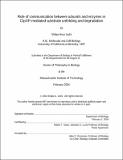Role of communication between subunits and enzymes in ClpXP-mediated substrate unfolding and degradation
Author(s)
Joshi, Shilpa Arun, 1975-
DownloadFull printable version (8.448Mb)
Alternative title
Mechanistic studies of Escherichia coli CLPXP's substrate unfolding and degradation cycles
Other Contributors
Massachusetts Institute of Technology. Dept. of Biology.
Advisor
Robert T. Sauer.
Terms of use
Metadata
Show full item recordAbstract
Chaperones and proteases play important roles in quality control by helping proteins fold, by dismantling hyper-stable complexes, and by degrading unwanted proteins. The highly conserved AAA+ Clp/Hsp100 proteins are ATPases which function as disassembly chaperones as well as essential components of energy-dependent proteases. For example, the ClpX ATPase disassembles macromolecular complexes and combines with the ClpP peptidase to form ClpXP, a molecular machine with structural and functional similarity to the eukaryotic 26S proteasome. ClpXP consists of hexameric ClpX rings stacked coaxially against the double-ring ClpP₁₄ peptidase. ClpXP's peptidase active sites reside in a sequestered chamber accessible through a narrow channel which excludes native, folded substrates. ClpX binds specific substrates, unfolds them in a reaction requiring ATP hydrolysis, and then translocates them into ClpP for degradation. When ClpP is absent, ClpX unfolds and releases specific substrates, an activity that can disassemble otherwise stable complexes. Although ClpX-mediated substrate unfolding and ClpXP-mediated degradation have been studied extensively, the role of communication between subunits within a ClpX hexamer or between enzymes in ClpXP has not been addressed. I initially screened numerous ClpX point mutants for their ability to support host-cell lysis by bacteriophage Mu, and then purified several mutants for functional characterization in vitro. Three of these mutants contained substitutions at intersubunit interfaces; these variants bound substrate well, but displayed unusual changes in ATP hydrolysis in response to substrate binding and had low protein unfolding activity. (cont.) These results suggest that communication across these subunit-subunit interfaces coordinates and regulates nucleotide hydrolysis in response to substrate binding and is critical for efficient substrate unfolding. I also discovered that ClpX and ClpP communicate with each other during substrate processing and degradation. ClpX binds ClpP more strongly during substrate unfolding than during translocation, by a mechanism that is linked to the ATP hydrolysis rate. Interaction between ClpX and DFP-modified ClpP, mimicking a peptide-cleavage intermediate, is strengthened significantly suggesting that ClpP also communicates its functional state to ClpX. Overall, this work suggests that communication within the ClpX hexamer and between enzymes in ClpXP modulates and coordinates substrate processing.
Description
Thesis (Ph. D.)--Massachusetts Institute of Technology, Dept. of Biology, 2004. Vita. Includes bibliographical references. This electronic version was submitted by the student author. The certified thesis is available in the Institute Archives and Special Collections.
Date issued
2004Department
Massachusetts Institute of Technology. Department of BiologyPublisher
Massachusetts Institute of Technology
Keywords
Biology.